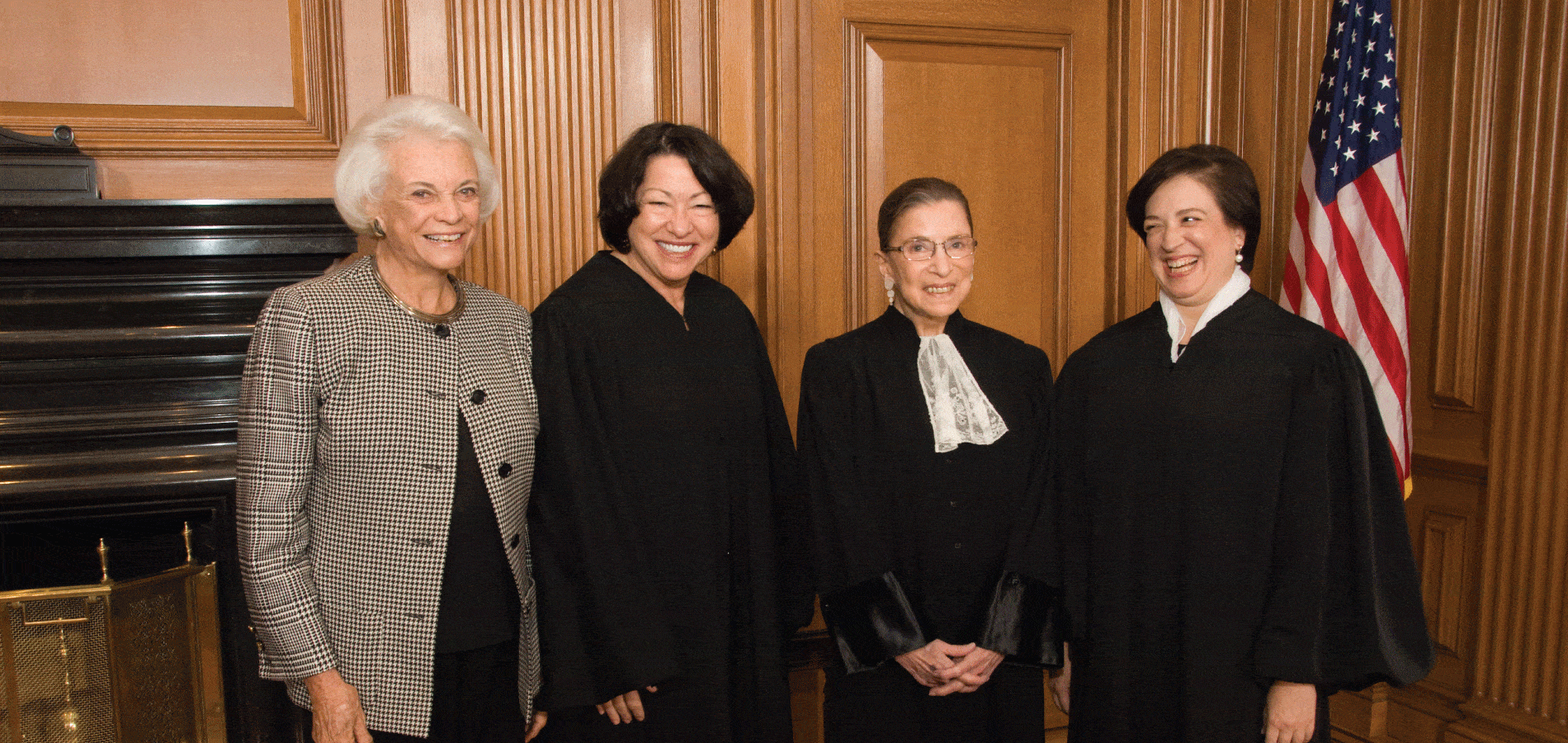At the end of May, the United States launched astronauts into space for the first time since 2011. What’s more, for the first time ever, these American astronauts launched in a spacecraft that was commercially built and operated.
The feat marks the next chapter in human spaceflight history, and gives renewed vigor to the relatively young (but already-growing) commercial spaceflight industry. But even the laws regarding world nations in space are at times unclear and hotly debated, raising the question: how will we regulate this greater involvement in outer space from private corporations?
Strap in as we launch this post into an exploration of space law. We’ll use these databases, so make sure you’re subscribed to follow along!
- Law Journal Library
- Foreign & International Law Resources Database
- Kluwer Law International Journal Library
- McGill Institute of Air and Space Law Publications
- United Nations Law Collection
- U.S. Congressional Documents
- U.S. Statutes at Large
- World Treaty Library
International Space Law Instruments
In October of 1957, the first man-made object was sent to space—Sputnik, a Soviet spacecraft named after the Russian word for “traveling companion.” The Space Race began, leading U.S. President Dwight D. Eisenhower to sign the 1958 Space Act, establishing the National Aeronautics and Space Administration (NASA). In the same year, NASA initiated Project Mercury, the first American human spaceflight program. Check out this blog post for an overview of the Space Race and the Apollo program.
While many around the world looked with dreamy eyes to the stars, others looked more practically to international law for guidance. Much about space was unknown and, therefore, unregulated, leading to calls for international cooperation before venturing any further. Within a year, the United Nations General Assembly created the Committee on the Peaceful Uses of Outer Space (COPUOS) to govern the exploration and use of this new frontier. In 1962, the Committee created two subsidiary bodies: The Scientific and Technical Subcommittee and the Legal Subcommittee, a primary forum for the discussion and negotiation of international agreements pertaining to outer space.
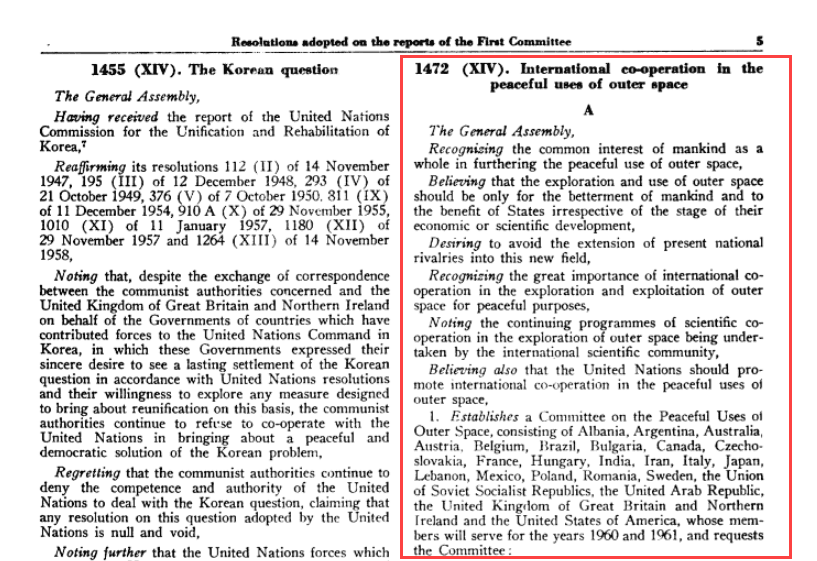
Over the decades, the Committee was instrumental in the creation of five treaties and five principles which serve as the primary framework for space law. Check them out below.
The Five Treaties
1. The Outer Space Treaty (1967)
The Treaty on Principles Governing the Activities of States in the Exploration and Use of Outer Space, including the Moon and Other Celestial Bodies (the “Outer Space Treaty”) is the primary instrument on which international space law is based. Ratified by 110 countries (and signed by 23 more), the treaty makes the following main points:
- The exploration and use of outer space must be for the benefit of all nations and for all of mankind.
- Space is free for all states to explore, meaning that sovereign claims cannot be made in outer space or on any celestial bodies.
- Nations must not station nuclear weapons or weapons of mass destruction in outer space or on any celestial body.
- Celestial bodies, including the moon, should only be used for peaceful purposes. The installment of military bases and fortifications as well as the testing of weapons on any celestial bodies are prohibited.
- Otherwise, activities in space should generally follow international law, including the Charter of the United Nations.
2. The Rescue Agreement (1968)
The Agreement on the Rescue of Astronauts, the Return of Astronauts and the Return of Objects Launched into Outer Space (the “Rescue Agreement”) requires states to assist any astronaut in distress and recover any crashed spacecraft that has entered their territory, regardless of its country of origin. No definition of “astronaut” is clearly provided, however, so it is unclear whether this agreement applies to non-astronauts (i.e., untrained personnel) in space.
3. The Space Liability Convention (1972)
Expanding on the liability provisions laid out in the Outer Space Treaty, the Convention on International Liability for Damage Caused by Space Objects makes states liable for any space object launched from within their territory (and for any damage it may cause). In other words, regardless of who launches a space object within a particular country, that country itself is liable for the consequences of the launch, rather than any individual, corporation, or government agency.
4. The Registration Convention (1976)
The Convention on Registration of Objects Launched into Outer Space (the “Registration Convention”) required states to provide details about each of their space objects to the United Nations, allowing them to be listed in a registry of launches. This provision allows organizations to help keep track of and avoid space debris.
5. The Moon Treaty (1979)
In the decade following the signing of the Outer Space Treaty, many felt that the legal framework for the use of outer space needed to be redefined. The Agreement Governing the Activities of States on the Moon and Other Celestial Bodies (the “Moon Treaty”) was an attempt at this redefinition, proposing the creation of an “international regime” to establish procedures for governing the behavior of states, organizations, and individuals in space, as well as the administration of resources between them. However, no consensus was able to be reached regarding the scope and definition of this regime or its laws.
States primarily disagreed about the rights of each country to space resources, and particularly those of the Moon. These disagreements can be seen within the United States, specifically when in 1980, the Senate Subcommittee on Science, Technology and Space held hearings on the Moon Treaty.
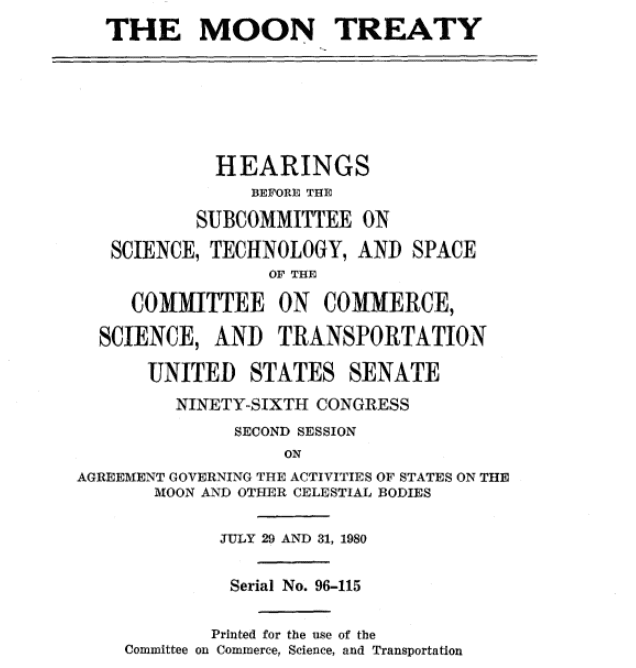
Still no consensus was reached, and ultimately fewer than 20 states became party to the treaty—none of whom were major space-faring countries.
Because the rights to space resources remained unclear, the U.S. government took matters into its own hands in 2015, legalizing commercial space exploration and mining with the U.S. Commercial Space Launch Competitiveness Act. Some experts argue that this contradicts the Moon Treaty and traditional international legal practice, but others say that the ambiguity of international law on the topic does leave the door open for commercial exploitation of space. Since the act, a number of other nations have passed similar legislation.
In 2018, another effort was made to come to consensus on the international legal framework proposed by the Moon Treaty, but failed once again. It was ultimately decided that negotiations would cease until the prospect of lunar mining and exploitation was more feasible.
The Five Principles
The five treaties listed above are supported by five sets of principles, also established by the Committee on the Peaceful Uses of Outer Space.
1. The Declaration of Legal Principles (1963)
The Declaration of Legal Principles Governing the Activities of States in the Exploration and Uses of Outer Space states that space exploration is open to all countries who will comply with international law, refrain from claiming ownership of any point in outer space, and return to the scientific community any objects or information. This set of principles laid the foundation for the Outer Space Treaty in 1967.
2. The Broadcasting Principles (1982)
The Principles Governing the Use by States of Artificial Earth Satellites for International Direct Television Broadcasting state that any country has the right to launch artificial earth satellites for this purpose. These activities should beneficial to all countries by offering the free dissemination of knowledge, but the broadcasting state should notify receiving states to establish this service.
3. The Remote Sensing Principles (1986)
The Principles Relating to Remote Sensing of the Earth from Outer Space deal with the “sensing of the Earth’s surface from space by making use of the properties of electromagnetic waves emitted, reflected or diffracted by the sensed objects, for the purpose of improving natural resources management, land use and the protection of the environment.” The principles state that these activities must be performed “for the benefit and in the interests of all countries,” consistent with international law and the Outer Space Treaty, and with the ability for other countries to participate.
4. The Nuclear Power Sources Principles (1992)
The Principles Relevant to the Use of Nuclear Power Sources in Outer Space seeks to protect the human environment on Earth by attending to the issues of safety, notice, responsibility, and damages that arise when using nuclear power in space. Written just six years after the Chernobyl disaster, the principles recognize the advantage and, at times, necessity of nuclear power in outer space activities. However, they formally state that it must be used in accordance with international law, with thorough safety and risk analysis, and with understanding that the state using nuclear power sources accepts full responsibility for its consequences.
5. The Benefits Declaration (1996)
The Declaration on International Cooperation in the Exploration and Use of Outer Space for the Benefit and in the Interest of All States, Taking into Particular Account the Needs of Developing Countries is a mouthful of a declaration that reiterates the necessity for international cooperation in space exploration. Specifically, the declaration calls for space-faring countries to encourage the progression of space science across the globe, to promote space-faring capabilities in any interested country (regardless of its level of economic development), and to foster the free and mutual exchange of expertise and technology among all nations.
Scholarly Work on Space Law
Major Space Law Center Publications
To help users begin their research in space law, HeinOnline provides access to four major space law center publications:
Journal of Space Law (available in the Law Journal Library) L.Q.C. Lamar Society of International Law
Air and Space Law (available in the Kluwer Law International Journal Library)
Kluwer Law International
Annals of Air and Space Law (available in the Law Journal Library)McGill University Institute of Air and Space Law
Proceedings of the International Institute of Space Law (available in the Foreign & International Law Resources Database)International Institute of Space Law
Searching in the Law Journal Library
To expand your research beyond these publications, use topic searching in the Law Journal Library. A number of scholarly works are available to understand the existing international legal framework for space exploration, and to get a sense of how space law will evolve in the future.
For example, perform an advanced search for a relevant term and then narrow your search using more than 1,500 machine-learned topics in HeinOnline. In the example below, we’ve chosen to research the commercial space industry within the topics of “Space Law” and “Air and Space Law.” Check out the results here.

Find an article you like? Use the More Like This tool to extract keywords from the article and automatically generate a list of similar results.
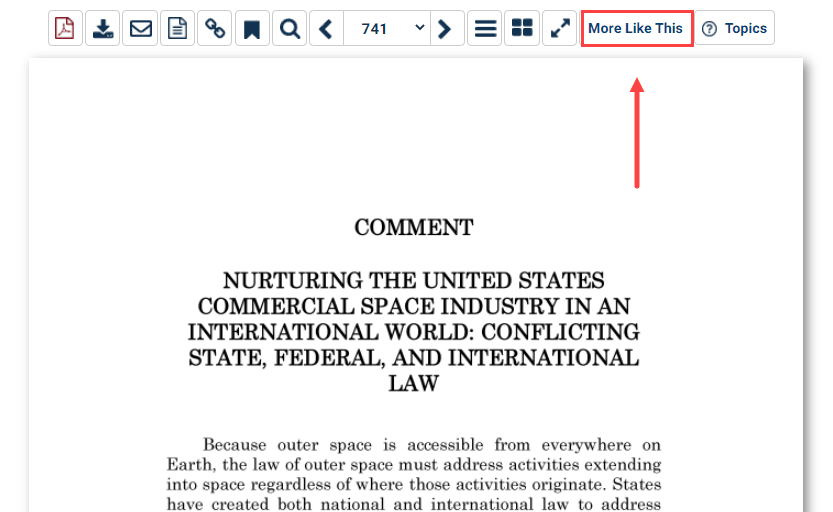
Edit the extracted list of keywords by removing a term, entering your own, and adjusting the boost factors of each.
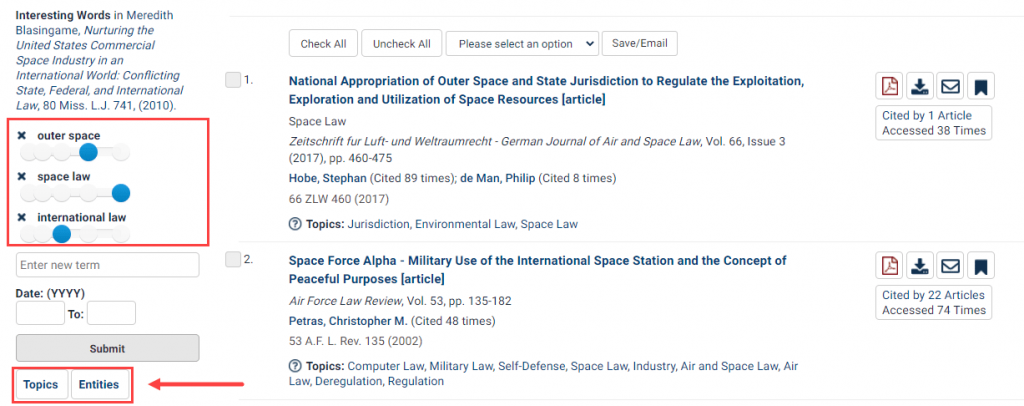
Utilize the Topics or Entities buttons to find additional similar results. Selecting the Topics button in this instance provides users with the top 10 articles and their topics that are similar to our article of choice.
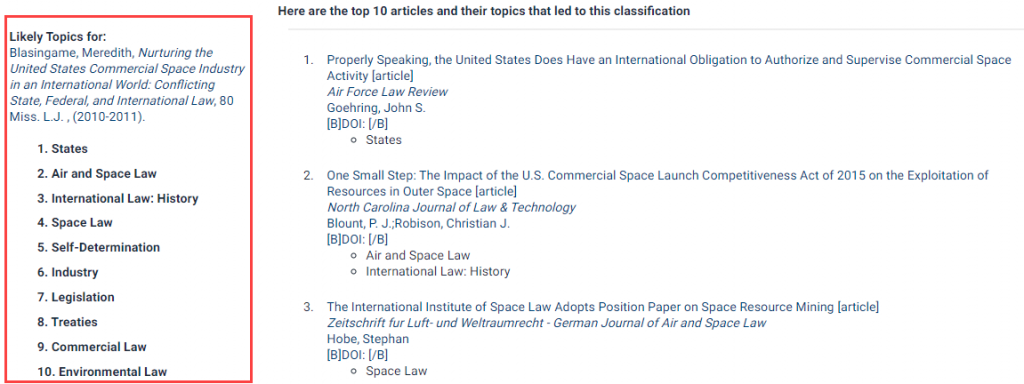
McGill Institute of Air and Space Law Publications
Interested in even more space-related content from HeinOnline? Check out the McGill Institute of Air and Space Law Publications. McGill University’s Institute of Air and Space Law (IASL) is the world’s premier academic setting for teaching and research in the dual disciplines of international air law and space law. The Centre for Research in Air and Space Law (CRASL) publishes leading literature in both disciplines, including the Annals of Air and Space Law (mentioned above), as well as treatises, monographs, and occasional papers.
Start your trial to McGill today to gain access to these essential space law resources.
Love to Research?
Here at HeinOnline, we love researching topics of all shapes and sizes. If you’re interested in discovering great research tips and tricks, staying in the know about new and upcoming content, and expanding your knowledge of a variety of disciplines, subscribe to the blog today!



